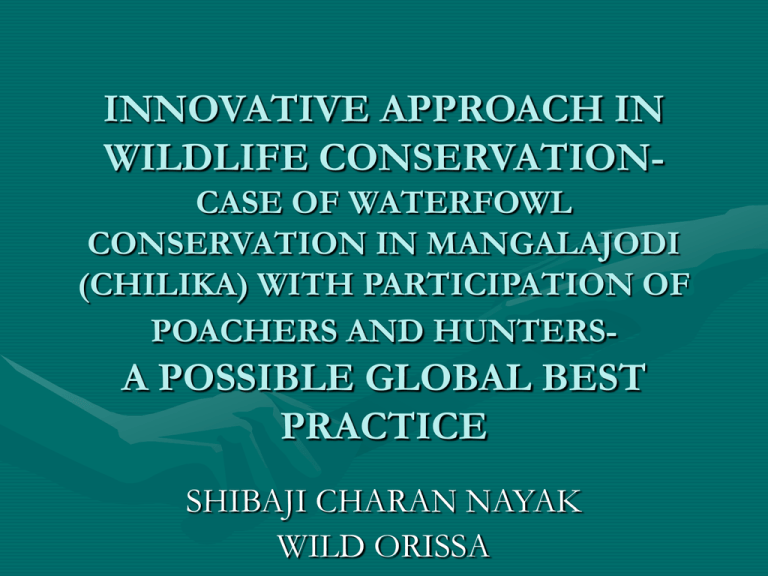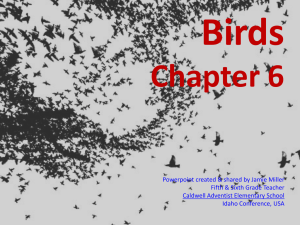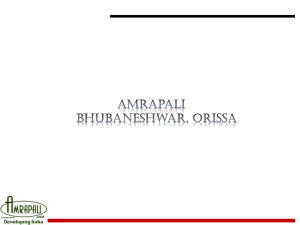innovative approach in wildlife conservation
advertisement

INNOVATIVE APPROACH IN WILDLIFE CONSERVATIONCASE OF WATERFOWL CONSERVATION IN MANGALAJODI (CHILIKA) WITH PARTICIPATION OF POACHERS AND HUNTERS- A POSSIBLE GLOBAL BEST PRACTICE SHIBAJI CHARAN NAYAK WILD ORISSA Chilika Lake, situated on the east-coast of India, is an estuarine lagoon, shallow throughout its spread of 1,16,500 ha. It is the largest brackish water wetland in India sprawling along the east coast. On account of its rich bio-diversity, Chilika was designated as a "Ramsar Site", i.e. a wetland of International Importance, in 1981. According to historical evidence, Chilika Lake was part of the Bay of Bengal about 6,000 years ago. Merchant ships used to travel from Chilika to South East Asia The Government of India has also identified the lagoon as a priority site for conservation and management. Chilika is the largest wintering ground for migratory waterfowl found anywhere on the Indian sub-continent. Chilika is one of the hotspot of biodiversity in the country, and some rare, vulnerable and endangered species listed in the IUCN Red List of threatened Animals inhabit in the lagoon for atleast part of their life cycle. The total number of fish species is reported to be 225. The Lake region also supports over 350 species of non-aquatic plants. In a recent phytodiversiy survey 710 number of plants identified from Chilika (within the water body, including the Islands and shoreline plants) were recorded. Some endangered species found in Chilika are: Barkudia insularis, a limb less lizard/skink (this skink is named after the "Barkuda" island of the lake) Irrawaddy dolphin, Orcaella frevirostris Fishing cat (Felis viverrina) White bellied Sea eagle, Haliaeetus leucogaster White spoonbill, Platalea leucorodia Osprey (Pandion haliaetus) Spoon billed sandpiper(Eurynorhynchus pygmeus) IMPORTANT AREAS FOR BIRDS Nalabana It is a marshy island covered with reeds famous for feeding & roosting of large-range of migratory birds in winter. Birds Island It is heaven for resident and migratory birds. Here one can watch birds in their natural habitat. Mangalajodi The marshy areas of Mangalajodi is another potential feeding & roosting ground of migratory water birds especially duck species & waders. MANGALAJODI • Mangalajodi village is located about 5 km from Tangi in district Khurda, 60 km from Bhubaneshwar. It is one of the villages surrounding Chilka Lake. This village is connected to the northern sector of Chilika Lake and Kalupada Ghat by way of channels dug through the Phragmites karka reed bed. The area includes Mangalajodi Ghera. Mangalajodi is primarily a freshwater zone with marshes, emergent vegetation and reed beds consisting mostly of Typha and Phragmites karka. There are aproximatly three hundred families in Mangalajodi village. The village is under Sundarpur Grampanchayat, of Tangi Block of Khurda district. The major occupation is fishing in Mangalajodi, which is mostly done in open Chilika and the channels connected with the Chilika. • There are 15 to 20 families in Mangalajodi (titled Behera) involved in agriculture mainly, while some fishermen hold small land submerged in water most of the time of the year. This land is used for cultivation of peculiar local variety seems to be wet resistant. There are some families who migrate from Bengal, collect a plant called ‘Sitali’, locally, and make traditional fishing nests out of it. Mangalajodi was found to have tremendous potential as a wildlife habitat and for becoming an excellent wildlife tourism spot. Threats in Mangalajodi Poaching and illegal trade of birds Reed Harvesting Poaching was causing irreparable damage to the avifauna of Mangalajodi. There were about 80 poachers in the village, proficient in various techniques of killing birds. These birds are regularly sold in the open market, at rates varying from Rs 20/- to Rs. 60/- per bird, depending on the species and method of killing. The local authorities were poorly staffed and pursuing the traditional protection methods. Each year thousands of migratory waterfowls like, pintails, bar headed geese, godwit, shell duck, etc. visit and breed in the wetlands around Mangalajodi village. Till the year 1996-97, poaching the birds and their eggs was done for house hold consumption and selling in nearby areas. This was one of the major sources of income for the poachers. Moreover, the collection of birds’ eggs and their sale in the open market was another big problem. Strict vigil was required to conserve the Mangaljodi waterfowl breeding habitat, by local participation in the form of patrolling, educating the masses about bird conservation and their habitat. Each year thousands of waterfowls like purple moorhen, purple heron, egrets, open billed storks, etc. breed in the wetlands around Mangalajodi village. Poaching of birds/water fowl in the Chilka Lake had been going on for hundreds of years, causing irreparable damage to the avi-fauna of this fragile eco-system. Different forms of killing had been practised including use of nets, traps, guns, poisoning, etc. The method of poisoning employed in these wetlands has been responsible for maximum deaths as with a little effort thousands of birds are killed. WILD ORISSA’s INTERVENTION Realizing the unabated poaching of waterfowl in Chilika lake and wild animals in the surrounding forests in Khurda it launched 2 (two) conservation programs, viz. the Chilika Bird Protection and Community Supported Control of Wildlife Poaching programs during 1996-1997. Its members had ventured into the village of Mangalajodi on the northern shores of Chilika Lake in the year 1996-97. The initial visits were met with anxiety and expectations, and coupled with a lot of misgivings there was also a faint hope that perhaps with sustaining the effort and perseverance and diligence coupled with a lot of personal involvement, hunting/poaching in this village could be brought under control. Members of Wild Orissa began to talk to the villagers about the need for protection of birds. The beginning was difficult but slowly Wild Orissa could manage to involve persons who were concerned for the birds viz. poachers. Initially there were serious difficulties but eventually with the help of enthusiastic and knowledgeable individuals including poachers in the village of Mangalajodi the issue of waterfowl poaching was discussed and suggestions were deliberated. During such deliberations the core persons were the poachers and hunters. Mr. Nanda Kishore Bhujabal, Governor of the Tangi Regional Chapter of Wild Orissa, and other members of Wild Orissa built a rapport with the villagers, especially poachers. Wild Orissa members involved themselves in each sad and happy moments of villager’s life, helped them to solve their problems, supported them in needs and constantly gave them realization about impact of bird poaching on village environment, eco-system balance, benefit of bird conservation by sitting and discussing constantly. The most important thing villagers realized was the feeling of ownership over Chilika birds which weren’t there earlier, which ultimately resulted in hardship for local people, split them from resources on which they depend from centuries. • This long term process of motivation got success when all the prominent, ruthless and important twenty five poachers from Mangalajodi decided to leave poaching and formed a committee for protecting birds, which they earlier used to kill. During the early part of year 2000 the local Divisional Forest Officer Chilika Wildlife Division Mr. Anoop Kumar Nayak also invited Wild Orissa to involve its members in containing poaching/hunting of waterfowl in Chilika Lake. The long associations with these people of Mangalajodi have stood Wild Orissa in good stead over the years. Direct intervention by way of apprehending poachers operating in the waters of Chilika Lake in and around Mangalajodi, with prior information on such activities, alongwith members of Wild Orissa and forest staff. Monitoring with members of Wild Orissa in the waters, especially in the poaching prone areas adjoining Mangalajodi waters, in both motorboats as well as in boats procured from local sources. Patrolling with members of Wild Orissa and forest staff, during odd hours, against poaching of bird eggs. Holding meetings with the forest staff of Tangi Wildlife Range and Mangalajodi Section. Holding of regular meetings with the members of the bird protection committee of Mangalajodi. Wild Orissa members engaged in documenting the rich flora and fauna in and around Mangalajodi Tackling the problem Of killing of birds Using nets, members of Bird protection Committee and Forest staff. Involvement of school children in boat excursions to the bird breeding habitats. Organising competitions on Chilika Lake and its birds, amongst school children of the area. Seeking interventions of the Chief Wildlife Warden, Irrigation Department, Chilika Development Authority, etc., on the fragile waterfowl breeding habitats. Ensuring some income generation for the poacher turned conservationists, which could help mitigate the poor economic conditions of these people, which would ensure their continuous involvement in water fowl conservation, through initiation of an Eco-Tourism Project in Mangalajodi village in the year 2003. Eco tourism Route and area In Mangalajodi Chilika. Recognition 1. The national and regional press and media widely covered this new approach and highlighted the same in many forums 2. The initiative of Wild Orissa became a subject for research by scientists and wildlifers 3. National agencies like Bombay Natural History Society, Chilika Development Authority, WWF-India, etc. recognized this effort and multilateral agencies like ABN AMRO Foundation, Royal Bank of Scotland, etc. also ensured support for this initiative 4. Government of Orissa bestowed the Pakshi Bandhu Award for the 2002 to the bird protection committee constituted by Wild Orissa 5. Government of Orissa bestowed the Biju Patnaik Wildlife Conservation Award 2008 to the bird protection committee SUCCESS • These efforts almost completely eliminated bird poaching here, and some of the ex-hunters have become die-hard conservationists. Members of bird committee undertook surveillance and patrolling on their own or with members of Wild Orissa and forest department in surrounding area of Chilika to check the bird poaching. The bird protection committee has also taken help of other villagers in bird conservation. • The committee members are also involved in various scientific projects like bird census, egg monitoring, etc. which educate them with english names of birds, however the long term experience of these ex-poachers enable them to identify birds, their eggs, their behaviour, important bird habitats, which prove to be very useful contribution for effective conservation of endangered birds. CONTD • The committee members also support and actively take part in research activities done in Mangalajodi area; they get involved in yearly bird census, bird movement monitoring and egg monitoring. • The initiative has helped to tackle the perenious problem of poaching of waterfowl in these parts of Chilika Lake. The containing of poaching has had a positive fall out of providing a safe haven for migratory waterfowl. It has helped create a base for future livelihood generation programs including that of wildlife tourism/eco-tourism. CRITICAL ISSUES • 1. 2. 3. 4. Critical issues which need to be addressed by all stakeholders in the coming years Sustaining alternative sources of livelihood for the erstwhile poachers and their families Retaining the core objective of involving the past poachers and hunters in income generating programs Mangalajodi happens to extremely sensitive to outside disturbances, and it is primarily because of the fact that it was all along cocooned from the external forces that it continues to be a thriving breeding habitat which needs to be protected at all costs. Wild Orissa has been able to identify the some factors which are/could be detrimental to this patch of the wetland, like increased human movements leading to disturbances to nest building and nesting/rearing. contd 5. Wild Orissa has already taken measures through the members of the bird protection committee to prevent overuse of these places by visitors. Instructions have also been given for protection of this site from outsiders, who unknowingly cause irreparable damage. 6. Wild Orissa has also observed that while monitoring the nests and eggs, by boats on foot, especially inside the Mangalajodi Ghera area, the nesting birds would get disturbed, and subsequently the crows (ravens) swoop on these exposed eggs and devour them. Visits to waterfowl breeding are not permitted. 7. Increased cattle movement- the dried lakebeds, are browsed upon by buffaloes and goats, which stamp upon bird nests. In normal circumstances, this should be a reason to be serious about. 8. Introduction of activities which disturbs the delicate ecological balance like excessive tourism which will disturb the ecological balance of the wetland habitat and also lead to overuse of resources contd 9. Introducing activities in excess of the carrying capacity of these wetlands viz. eco-tourism 10. Oil spill from motor boats- a number of boats ply in these waters all the year round by the villagers for fishing as well as transport. Care should be taken that when eco-tourism takes place in a bigger manner, then use of eco-friendly modes of transport should be resorted to 11. The area is prone to ill-directed developmental activities which would cause demise of this habitat, like well digging, artificial fish feeding, artificial prawn farming, etc. It is imperative that only activities should be encouraged, which don’t cause any harm to this fragile wetland. CONCLUSION •A NEW APPROACH AT WILDLIFE CONSERVATIONPRACTICED •A DEDICATED WILDLIFE BRIGADE CREATED •WATERFOWL CONSERVATION OCCUPIES CENTRE STAGE •ENLARGING OF SOCIAL INTERACTIONS- VISITS FROM ACROSS THE GLOBE •A NEW BASE/OPTION/SUBJECT FOR CONDUCTING RESEARCH contd DIFFERENT STAKEHOLDERS JOIN HANDS IN AN UNIQUE MOMENT •ORGANISATION IN NON GOVERNMENTAL SECTOR •ORGANISATION IN GOVERNMENTAL SECTOR •POACHERS AND HUNTERS •LOCAL COMMUNITY •GOVERNMENT •INTERNATIONAL INSTITUTIONS •EDUCATIONAL INSTITUTIONS •WILDLIFE CONSERVATION BODIES contd •A TRANSPARENT APPROACH TO ISSUES AT GRASS ROOTS LEVEL •EMPOWERMENT OF PEOPLE •SELF BELIEF •MANGALAJODI- BECOMES A FAMOUS TOURIST DESTINATION •A TRULY COMMUNITY LEVEL INCOME GENERATING PROGRAM PRACTICED AND SUSTAINED THANK YOU








